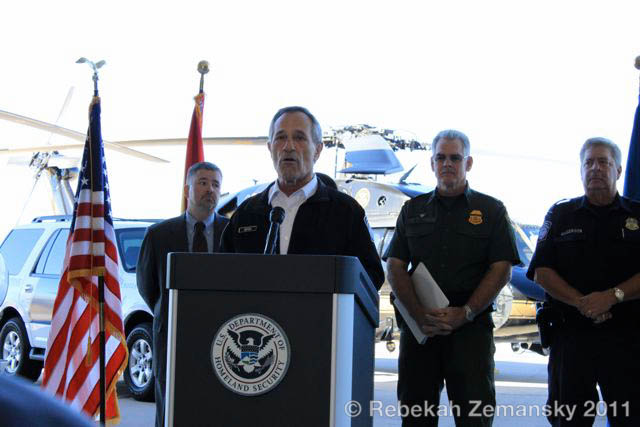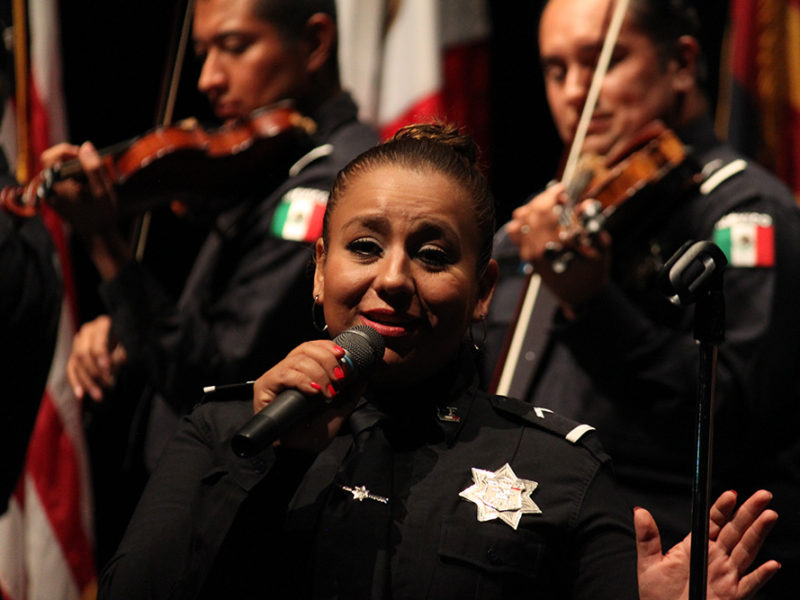Starting this month, I’m forwarding missing persons reports submitted to Missing from Mexico (through the blog and / or social media) directly to Colibri Center for Human Rights. They also take reports directly here. Also this fall is bringing several new projects. I’m excited about them and hope to share more about them here in the future. In the meantime, Missing from Mexico will be going on indefinite hiatus.
Arizona
Stirred up and shut down: what it’s like to cover protests
|
(a post event coverage from The Tucson Sentinel 16 October 2013 piece Border activists declare victory after protest at closed Phx ICE HQ)
Protests, rallies, marches – they’re all different ways of describing a big public event with passionate people. And that means a big, loud, exciting mix of challenges and opportunities for reporters trying to cover what’s going on. Sometimes there’s also the people who disagree so strongly they’ll come out and counter protest. This can be a great way to get a mix of viewpoints – or to get caught between two groups shouting. As my professor for 20th century media and entrepreneurship (real class) says, someone yelling from one side and someone yelling from the other side doesn’t make balanced reporting, it makes two people yelling at each other.
Arizona
Planning for the unexpected: community advocates urge immigrants to prepare for raids
|
(a post discussing sourcing with examples from backgrounding work I did on The New York Times 19 August 2013 piece Carwash Managers Held in Immigration Raids)
“We’re asking all the families to please prepare in case of these emergencies to know that they have the right to see an attorney, they have a right to a call and of course at every moment it’s so important to have an emergency plan for when things like this happen,” ACLU Arizona Immigrants Rights Project Coordinator Dulce Juarez told reporters at a rally in front of Immigration and Custom Enforcement’s Phoenix field office Monday afternoon. I’d heard the message before at a school assembly for parents last fall when community organizers gathered parents, pastors, and politicians to discuss how to protect children of undocumented immigrants, sometimes U.S. citizens and sometimes undocumented themselves, in a situation where anything from a workplace raid to a traffic stop for a broken tail light or speeding can throw the family into every kind of limbo with no warning: undocumented immigrants should have emergency plans in place to protect their children and their assets because it may be too late to make arrangements once they’re apprehended. “We’re asking all the families to please prepare in case of these emergencies to know that they have the right to see an attorney, they have a right to a call and of course at every moment it’s so important to have an emergency plan for when things like this happen,” said Juarez. This isn’t the story I was assigned to cover – but it’s another side of living here. Organizers from Puente Arizona and National Day Laborer Organizing Network had gathered protestors to support 30 workers still in detention after federal agents raided 16 Danny’s Family Car Wash locations in Phoenix on Saturday morning to make arrests in a criminal identity theft investigation and also detained 223 people, most of whom were quickly released, on immigration status checks.
Arizona
Uncertain future for detained #Dream9: an example of sourcing the story
|
(a post discussing sourcing with examples from backgrounding work I did on The New York Times July 23 piece 9 in Deportation Protest Are Held in Bid to Re-enter U.S.)
This week on Tuesday, I got invited to help locate sources and gather background information for a brief follow-up story that Julia Preston was working on. A big part of reporting is reaching sources – and this becomes doubly high pressure when working on a breaking news or developing story. The day before, nine protesters were intentionally apprehended in Nogales on Monday morning. In press releases sent out before the event, protest organizers said that eight young immigrants who’d grown up in the U.S. but then had either voluntarily left or been deported would be protesting family separation (a ninth person joined the initial eight during the protest). They’d try to cross the U.S.-Mexico border at Morley Gate, a pedestrian crossing between Nogales, Sonora and Nogales, Arizona and request humanitarian parole.
behind the scenes
Family through a fence
|
A bittersweet reunion lets three young immigrants see – and reach for – their deported mothers through a fence. Read more here in the June 11 The New York Times piece: Immigrants Reach Beyond a Legal Barrier for a Reunion
As a young man and two young women approached the border from the Arizona side, a cry rang out through the bars of the border fence. Waiting for their children in matching turquoise t-shirts on the Mexican side were their mothers, separated for years since their deportations for being illegally present in the U.S.
The six came together, reaching through the spaces between the thick metal poles, with sobs and laughter under the watchful (and not always dry) eyes of organizers, reporters, Border Patrol, and Mexican Federales last Tuesday – the culmination of days of travel and two months of planning. All three children are in President Obama’s Deferred Action for Childhood Arrivals program which gives qualified applicants the ability to go to school, work and in some states get drivers licenses while they wait for a more permanent resolution to their legal status limbo. It’s a way for participants to start coming out of the shadows.
behind the scenes
Searching for Andy at PCOME: Database debut leads to Tucson travels
|
A publicly accessible website went online one week ago that provides maps and data based on the location where bodies presumed to be migrants have been recovered in southern Arizona. The Arizona OpenGIS for Deceased Migrants is “the result of ongoing partnership” between the humanitarian group Humane Borders, Inc. and the Pima County Office of the Medical Examiner (PCOME). And so I ended up in a southbound car with New York Times reporter Fernanda Santos and freelance photographer Joshua Lott to learn about how the database works. In the years since the first time I visited PCOME, many things have changed. Dr. Bruce Parks, whom I interviewed for Unidentified dead common on the border, retired in the summer of 2011 and Dr. Gregory Hess is now the medical examiner.



